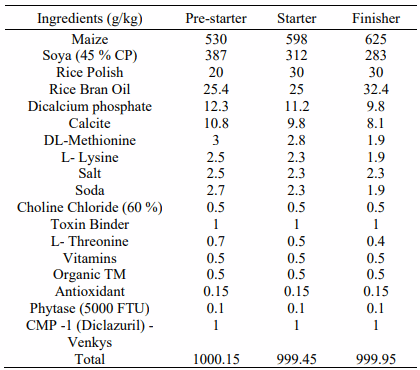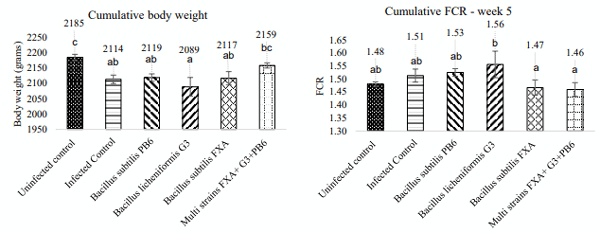I. INTRODUCTION
Growing concern over the use of antibiotics due to the rise in antimicrobial resistance and rising consumer demand for antibiotic-free products is increasingly becoming a challenge for poultry production. There is a need to identify natural and economical alternatives such as probiotics. The supplementation of probiotics as an antibiotic growth promoter (AGP) alternative in poultry production has the potential to improve poultry health, performance, growth, and feed efficiency (Reuben et al., 2021).
Avian pathogenic Escherichia coli (APEC) infections in poultry are associated with major economic losses to the poultry industry worldwide. Colibacillosis, caused by APEC, is typically a localized or systemic disease that occurs in poultry when host defenses have been compromised by virulent APEC strains (Lutful Kabir et al., 2010). The treatment or prevention of colibacillosis is accomplished by using antibiotics, such as colistin sulfate. However, the emergence of antibiotic-resistant bacteria has reduced the efficacy of antibiotics and may pose considerable risks to human health (Wang et al, 2017). Thus, there is a need for alternatives to antibiotics. Studies have shown that the translocation of these pathogenic bacteria may be reduced by the presence of probiotics in the intestine (Isroli et al., 2018). The present study intended to determine whether the feeding of Bacillus probiotic as a single strain and in combination would reduce the translocation of APEC and thereby reduce the severity of infection in the poultry model.
II. METHOD
A five-week broiler avian pathogenic E. coli challenge trial was conducted as part of screening studies for potential probiotics at the in-house Kemin poultry research farm, Gummidipoondi, Chennai, India. The trial was conducted using 432 one-day-old Cobb-430 male chicks. The chicks were procured from Komarla Hatcheries, Pollachi, India. The birds were divided into 6 groups with 6 replicates and 12 birds per replicate in a total of 36 pens of 4 ft x 4 ft (1.18 sq. ft/bird). The details of the treatment groups are shown in Table 1. A completely randomized design was adopted to minimize the effect of environment and management on different groups. All the birds were reared under a deep litter system with paddy husk bedding throughout the experimental period. Paddy husk was processed by spreading the material in sun for about 4 days, after which bleaching powder, lime powder, and omnicide (disinfectant) were sprinkled and used for bedding. The E. coli strain was isolated from colibacillosis-infected birds on a commercial farm. On day 7, birds were orally challenged with 1.0 mL (2 × 106 CFU/mL) of freshly grown APEC (Internal ID - EC20UT) field strain isolated from the colibacillosis-infected birds using a 1 mL pipette or syringe. The unchallenged group was administrated with the same volume of saline solution.
Table 1 - Details of the probiotic treatment groups in APEC challenged and unchallenged broiler birds.
Table 2 - Ingredient of experimental diets.
All birds were fed a starter diet from 1 to 14 days, a grower diet from 15 to 28 days, and a finisher diet from 29 to 35 days. The weekly parameters monitored were body weight, feed intake, feed conversion ratio (FCR), and mortality. Birds had access to ad libitum clean drinking water including sanitizer and acidifier. The birds were vaccinated for Newcastle Disease and Gumboro Disease on the 5th and 12th day, respectively.
Table 3 - Chemical composition of experimental diets.
Statistical analysis of the data for cumulative body weight and FCR was performed using Statgraphics Centurion XVI.II software. Data were analyzed by one-way analysis of variance (ANOVA). A P value of < 0.05 is considered statistically significant.
III. RESULTS AND DISCUSSION
The performance on day 35 of birds receiving the probiotics treatments as well as the control are shown in Figure 1. Since this was a part of a screening trial with a low number of replicates, there was a high variance in performance due to mortality.
Figure 1 - Effect of multi-strain probiotics on body weight (left) and feed conversion ratio - FCR (right). Bars with different superscripts indicate significant differences (P < 0.05).
In terms of body weight gain, the multi-strain probiotics group showed improvement by 45 g in comparison to the infected control (P > 0.05). However, in terms of FCR, multi-strain supplemented groups showed 5 points difference while the uninfected control showed 3 points as compared to the infected control group (P > 0.05).
Figure 2 - Effect of multi-strain probiotics on mortality reduction.
Supplementation with the single strains group did not reduce mortality, whereas supplementation of the multi-strain probiotics resulted in a 25 % reduction in mortality compared to the infected control birds. The beneficial effect of Bacillus probiotics could be due to factors such as the production of organic acids and bacteriocins with a bactericidal action (Wang et al., 2017). Although single-strain probiotics are beneficial to the host, multi-strain probiotics might have additional benefits in terms of performance due to synergism and additive effects among the individual isolates (Kwoji et al., 2021).
IV. CONCLUSION
Overall, the present study results suggest that supplementation with multi-strain probiotics (FXA, G3, and PB6) can reduce mortality in colibacillosis-infected birds in comparison to single-strain supplementation. These findings indicate that multi-strain Bacillus probiotic supplementation has the potential to be used as an alternative to antibiotics, especially for the control of avian pathogenic E. coli. Further research on the effects of multi-strain Bacillus probiotics supplementation is needed to elucidate its effects on gut microbiota.
Presented at the 34th Annual Australian Poultry Science Symposium 2023. For information on the next edition, click here. 













.jpg&w=3840&q=75)